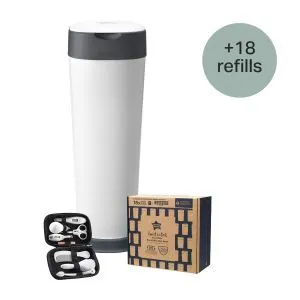
Ultimate XL Nappy Disposal Bundle with 18 Refills
Bundle & Save 40%
Subscription orders can be cancelled at anytime. Free delivery on all subsequent subscription orders. Find out more about subscriptions.
They’re easy and fuss free
Your products are automatically sent to you
You save up to 10% when you sign up for a subscription
You can cancel at any time

Powdered baby formula is not sterile, so hygiene and protecting your baby's immune system should always be at the forefront of your mind when you're making a bottle of formula.
To reduce the risk of infection, every piece of feeding equipment you use should be thoroughly cleaned and sterilised before every feed. This should be done until your baby is 12 months old. You should also always follow the instructions on the formula's packaging carefully when you make up a bottle feed.
*Based on a 5oz feed, room temperature water tank, refers to time from start of hot shot to completion of cool shot.
**Based on preparing a 120ml feed with boiling water and cooling to 40°C.
Explore the Range
If there's any formula left over after your baby's finished feeding, you should dispose of it within two hours.
Now that we've covered how to make a bottle of baby formula at home, let's tackle how to prepare a feed for your little one when you're on the go.
If you need to feed your baby when you're away from home, you'll need:
If you're not able to follow the above steps or need to take a feed to your baby's nursery, you can make up their bottle at home, cool it, and pop it alongside an ice pack in a cool bag.
Formula stored:
Alternatively, you can use a carton of ready-to-feed liquid formula to feed your baby when away from home. Liquid formula milk is sterile until opened. However, all feeding equipment will still need sterilising.
Once it's been opened, any liquid infant formula that is unused should be stored on the top shelf at the back of the fridge, for no longer than 24 hours.
It's not recommended to reheat baby formula. Here's why:
Never microwave formula. This can create hot spots that could burn your baby's mouth. If your baby prefers warm formula, you can warm it once by:
Bottled water isn't recommended for preparing formula feeds. This is because it's not sterile and can sometimes contain high levels of salt or sulphates. It can, however, be used occasionally if you're travelling to a country where the tap water is not safe for drinking.
If you need to use bottled water to prepare a formula feed:
Formula that’s made up at home and stored at room temperature must be used within 2 hours.
Yes, if you follow safe preparation guidelines, you can give your baby a mix of breast milk and formula in the same bottle.
If you decide to do so, you should follow the manufacturer's instructions exactly when preparing the formula, before adding your expressed breast milk. When mixing formula, never substitute water for your breast milk.
There are a few reasons why a formula-fed baby might suddenly refuse a bottle. Here are some of the most common:
They don’t like the teat on the bottle: Some babies prefer a certain type of teat. If the teat on the bottle you’re using is not the right size or shape, your baby may have difficulty sucking from it.
They’re teething: Teething can make babies fussy and irritable, and they may not want to feed as and when they normally would.
They’re feeling sick: If the baby has a cold, ear infection, or other illness, they may not want to eat or drink according to their usual schedule.
If your baby is suddenly refusing a bottle, it is important to rule out any underlying medical conditions. If you are concerned, you should talk to your doctor. They may be able to help you identify the underlying cause of the problem and recommend a solution.
If your baby is refusing the bottle at a certain time of day, try offering it at a different time, and you should always let your baby take the bottle at their own pace. Read our full guide on bottle acceptance tips here.